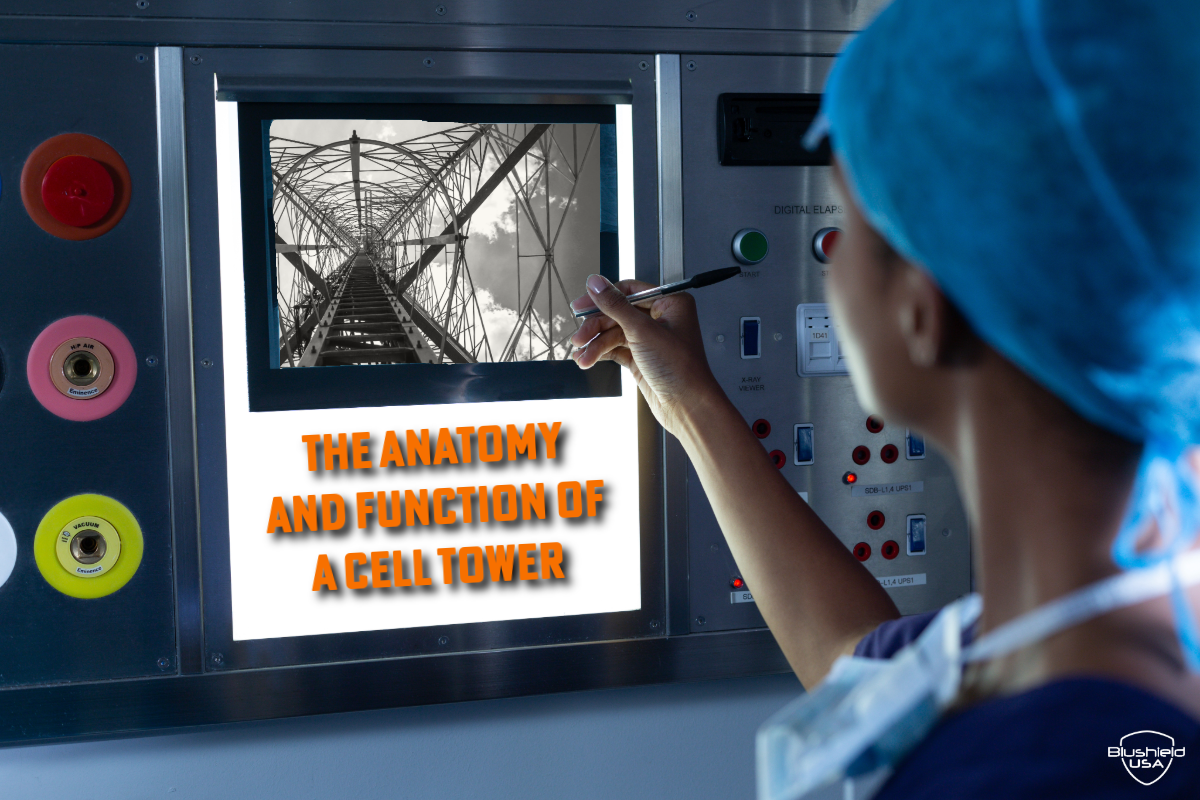
We are living in a unique and novel time where technology is rapidly progressing, and our daily lives are becoming continuously more deeply intertwined with these emergent phenomena. A major component that enables modern technology to exist and function is the cell tower. Most of us, especially those who live in urban areas, have gotten used to cell phone towers dotting the backdrop landscape of our lives, and even those of us living in rural areas usually have at least one large, looming tower in view, off in the distance.
Even though cell towers have become commonplace in our daily lives, how much do most of us actually know about them? It’s easy to recognize the large lattice and monopole cell towers that reach as high or higher than the buildings around them, but did you know that there are several other types of radio frequency transmitting structures in the cell tower category that you may not recognize at all?
Cell towers come in so many forms (each suited for different uses) that a lot of people are astonished to find out how many cell towers are actually in their vicinity. We use a cell tower and antenna map website called Antenna Search to determine the number and location of towers and antennas in relation to a person’s home, to determine which Blushield device is best suited for their needs (which is mostly related to overall EMF density). We’ve noticed that many people are surprised to find out that the tower numbers in their area considerably exceed what they had previously assumed.
Therefore, it can be helpful to learn more about cell towers, so we can recognize them when we see them in our environment, enabling us to take appropriate precautions and protective measures while in their vicinity. It’s also good to learn how cell towers actually work to transmit signals between our phones, computers and the internet, as some may assume it’s all just a big informational cloud in the sky, which isn’t the case!
Cell towers act as intermediaries between wireless devices like cell phones, and the hardwired mobile network core that routes information to its destination, usually through another cell tower that’s nearest to the destination device. The majority of the actual data transmission happens through a hard wired connection on the ground, and the aerial transmission is only a very small portion of the journey of any given voice, text or data transmission packet.
The word “cell” is used because each tower covers a specific range, called a cell, that’s roughly hexagonal in shape for optimum coverage and transmission. Adjacent towers cover the surrounding areas, and if you could visibly see the connecting coverage areas (with the hexagonal range each tower covers), it may look similar to a honeycomb or beehive. Cell phones used within a cell that provides coverage to the mobile carrier that phone uses (Verizon, AT&T and others) will interact directly with that cell tower by transmitting and receiving wireless information packets.

How exactly does a cell tower support data transmission?
Let’s use a standard large cell tower (like a lattice or monopole tower) as an example, to learn more about how this works. The antennas on the tower each operate within a specific frequency band, often referred to as its spectrum. Each mobile carrier that leases space on a particular tower has its own antennas that operate within its own spectrum, so it won’t interfere with the transmission from other carriers. Any given spectrum is divided into separate sections for uplink and downlink transmission, to ensure that two-way communication can occur without obstruction or interference. Uplink refers to the communication path from the mobile device (such as a cell phone) to the cell tower, and downlink is the communication path from the cell tower to the mobile device. The data packets sent between a mobile device and cell tower ride on a specific carrier frequency, and the data itself is encoded onto that carrier usually by modulating the amplitude or phase of the signal in a very intricate and complex way, which “writes” the information onto the wave with exact accuracy.
When this information-carrying radio wave is picked up by a nearby antenna that’s attuned to the same frequency, the transceiver then demodulates the signal to extract the original information. The transceiver is a piece of equipment that sits next to the antenna itself, high up on the cell tower. The demodulated data is then sent down the tower through a physical cable, usually a fiber optic or coaxial copper cable, to the base station that resides at the bottom of the cell tower.
From there, the data is sent through the backhaul portion of the network. Backhaul is the wired or wireless infrastructure that connects the cell sites to the central mobile network. Most of the time, backhaul connections are wired using fiber optic cables, which are preferred for their high bandwidth and reliability, but in some cases wireless infrastructure like satellites are used instead.
As the data packet travels through the backhaul, its next stop is an aggregation point, which is where data from all the cell towers in that area pass through, to be routed further to the network core. It’s kind of like a traffic intersection near a highway, where many information streams meet in the same area to get on the highway to the big city. From there, the data packet travels to the network core.
Network cores are called different things, depending on what type of data they are responsible for handling. The predominant type of network core in the past, which is still used for voice calls, is called the mobile network switching center (MSC), and is responsible for “switching” phone calls to their final destination. For data packets used for sending texts, and processing data from internet usage on wireless devices, 4G LTE network cores involved in these processes are called Evolved Packet Cores (EPCs), and 5G ones are simply called 5G Cores.
Whichever type it is, networks cores are like the central hubs (or the brains) in a complex web of mobile communication, and they play many roles. These centers are responsible for determining the rest of the route for your data packet to reach its final destination, and sending it on its way. They are also responsible for seamlessly handing off a connection from one cell to another, if the mobile device user is traveling between zones while using data or making a call. Another role the network core plays is to facilitate communication between different mobile networks, if you’re communicating with someone who uses a different carrier. The core infrastructure is housed in buildings called data centers.
After the data packet moves through the network core, the whole process essentially reverses as it moves toward its destination, which is usually a cell tower in the most suitable location to send the information wirelessly once more, to a mobile receiving device.
This whole process occurs almost instantaneously.

Macrocells, microcells, picocells – oh my!
Now let’s look at the various forms that cell towers can take. Some are very tall and large, and can be seen from miles away. These large towers include lattice, monopole and guyed towers, and are heavy duty, well supported structures. They provide service to a broad geographical area and are designed to handle a significant number of mobile users – this type of coverage size and capacity is referred to as a “macrocell”. Depending on the frequencies used by the antennas, and the transmitter power level, the maximum usable range can reach long distances of 10-25 miles (even up to 45 miles in some cases), but typically have a range of 1 to 3 miles.
- Lattice towers are open frame steel or aluminum structures with three or four legs, which taper moving upward, and can host multiple antennas at various levels on the structure. They usually range between 200 and 400 feet in height, but occasionally reach up to 1,000 feet.
- Guyed towers are very tall masts supported by many guy wires along different points on the structure, and anchored to ground foundations. They can reach anywhere from 200 feet tall, all the way up to a towering 2,000 feet. This type of tower is useful in areas with high winds, for additional support. The guy wires allow the structure to reach greater heights, making it more useful for the broader ranges used by FM and AM radio (which use lower frequencies with longer wavelengths, thus traveling farther), as well as the wider ranges of 4G and 3G cell phone signals, especially in rural areas.
- Monopole towers are single vertical poles made of galvanized steel or reinforced concrete, with antennas mounted at various levels on the exterior, and are usually between 50 and 200 feet tall. They are commonly seen in big cities, and these shorter towers have a smaller range, often using higher frequencies for more intensive data transmission. Even though they are shorter than lattice and guyed towers, they are still tall and powerful enough to provide macrocell level coverage.
- Stealth towers come in several different forms, and are designed to blend stealthily into their surroundings, as their name suggests. This may mean installing antennas on flagpoles, water towers, clock towers and church steeples, and even small towers made to look like trees. This is the type you’re least likely to notice, but if you start to look closely at the tops of water towers and other high structures, and trees that don’t quite look like trees, you may see cell antennas cleverly integrated into these common landscape features. These are most common in urban and suburban areas, and are sometimes necessary to follow zoning regulations concerned with aesthetics.
The last tower type listed above, the stealth tower, is versatile and can support either macrocell or microcell needs, depending on its size and power level. A microcell is a smaller cell, designed to cover a more limited area. Microcells overlap with the larger macrocells, and are designed to enhance capacity and coverage in certain high density or heavily trafficked areas, especially crowded urban spaces. Stealth towers that support microcell zones are often found on lamp posts, traffic light poles, and other common city infrastructure. Microcells are a type of small cell, and are integral to the denser and higher capacity coverage of the new 5G networks.
Besides some kinds of stealth towers, most small cells do not exist in a traditional tower form. The antennas and equipment are placed on other objects, as they are highly localized to a smaller area, designed to overlap other cells to enhance coverage. Small cells in general are placed between 20 and 100 feet high, depending on the type.
Even smaller than microcells are picocells and femtocells. Like a Russian nesting doll, these smallest cells rely on the base coverage of macrocells and microcells in the area, then enhance coverage even more in areas of high need, like a single building, a floor within a building, or even a single home or office. Picocell equipment is sometimes installed outdoors on lamp posts and other objects, but is more often utilized in large indoor spaces like airports, stadiums, hospitals, hotels, universities and offices. Femtocells are used exclusively indoors in smaller spaces, mainly to enhance coverage within an end user’s home or office.
4G service was the standard almost everywhere until recently, and is estimated to run on about 80% macrocells and 20% small cells. Inversely, 5G is heavily reliant on small cells, with up to 80% of 5G data transmission occurring through small cells, and only 20% through macrocells. Currently in the United States, there are over 450,000 active small cells. 5G is expected to become the dominant technology by 2030, which would require the number of small cells to more than double, up to an unbelievable 900,000 to 1 million small cells throughout the country.
The reason that 5G is so heavily reliant on small cells is because it utilizes a much higher frequency spectrum than 4G (often simply referred to as ‘millimeter waves’), and higher frequencies can’t travel as far, so require significant infrastructure densification. They are closer to the ground (where people and their devices are), and closer to each other, often existing on every street corner in populated urban areas. You can learn more about how 5G works specifically in a previous article we wrote on the topic:
5G Explained and What It Means for Health and Humanity
Here are the coverage differences between the cell zones explained above:
- Macrocells provide coverage at distances greater than 3,000 feet
- Microcells cover 600 to 3,000 foot zones
- Picocells enhance service in 300 to 1,000 foot areas
- Femtocells provide highly localized coverage within 100 feet or less
Cell towers (macrocells) and microcell antennas are owned and installed by the mobile carriers that use them, or by infrastructure operators. They are quite expensive to build, the average large cell tower costing about $250,000. Picocells and femtocells are often provided upon request by mobile carriers to their customers, usually but not always for an additional fee.

What are the different kinds of antennas?
The purpose of cell towers is to act as supportive infrastructure for the actual antennas that transmit the frequencies. Most types of antennas need to be placed on tower structures to give the antenna enough range to cover a large area. There are several different types of antennas you will see when you start looking more closely at the different types of cell towers described in this article.
One of the most common types of antennas used in 4G infrastructure are panel antennas. These appear as flat, white rectangles on monopole and lattice towers. They can be part of the way up the tower, all the way at the top, or more commonly both. Panel antennas transmit frequencies into certain sectors in the general direction they’re pointing, which is why you often see them installed on a triangular structure that surrounds the tower, with a few panel antennas on each of the three sides. This is so that there is antenna coverage in each sector within the zone of that tower, since each panel antenna can cover a section 120 degrees across, so with three sides there will be a full 360 degree coverage. They are most often found in urban and suburban locations, along highways and in densely populated regions.
Parabolic antennas, also called dish or circular antennas, are circular and concave like a dish. These are often located on monopole or lattice towers where panel antennas are also installed. Parabolic antennas are not involved in data transmission to and from mobile device users, but are used to transmit larger streams of data between nearby cell towers. The dish shape creates a focused beam in the direction it’s pointing. These antennas can be involved in the smaller percentage of backhaul that’s done wirelessly (most if it is ground based using fiber optic cables, as explained above), or other scenarios where a focused, high-gain, point-to-point signal is needed.
Omnidirectional antennas are thinner and less obvious, and often appear as metal rods in various formats. They are commonly seen at the top of tall guyed and lattice towers, and reach very long distances, which is useful in rural areas. Omnidirectional antennas can send and receive signals in all directions (360 degrees), hence their name. They provide broad coverage over a wide area.
As mentioned in the previous section, small cell antennas are not found on regular cell towers. Most often, they are installed on various urban infrastructure like street lights, traffic lights, buildings, and even on trees. 5G is completely reliant on small cells, and there need to be many of them placed close together to support the higher frequencies and larger bandwidth of 5G. They are designed to be as unobtrusive as possible, and may blend almost seamlessly into surrounding objects. They can be box-shaped, cylindrical, or even concealed within other objects, making them invisible to the eye. Small cell antenna housing contains multiple antennas arranged in an array, supporting the MIMO technology that’s central to 5G.
There are other types of antennas that are used in special, less common circumstances, but these are the main ones you will see and interact with in your environment.
Cultivating awareness of our EMF exposure
Part of becoming aware of the effects of electromagnetic fields on our bodies is learning more about the EMF sources all around us. Even those who are sensitive and reactive to EMF sources may not be educated enough to recognize a prominent source of harmful frequency fields in their environment. Being informed of our surroundings brings greater awareness and discernment into our lives, and while we cannot get away from these sources completely (and many of us don’t want to anyway), we can sensibly limit our exposure whenever possible.
This knowledge also makes it possible to ensure you are adequately protected by using an appropriate strength Blushield home device, which you can determine by factoring in your combined total of EMF exposure sources (detailed in our Blushield Product Guide). When you’re out and about, driving through the city or at the office, you may start noticing small cell equipment that you didn’t recognize before, and can make sure you’re carrying a Blushield portable with you in places that utilize small cell equipment.


